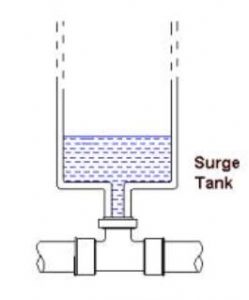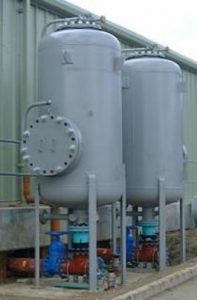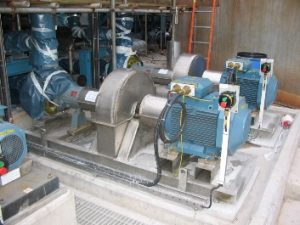WHAT IS WATER HAMMER?
Water hammer occurs when the flowrate of fluid in the pipe changes rapidly. It is also known as “surge flow”. It can cause very high pressures in pipes, very high forces on pipe supports, and even sudden reversals of flow. It can cause burst pipes, damaged supports and pipe racks, and leakage at joints.
Water hammer can occur for any fluid, in any pipe, but the severity varies depending on the detailed conditions of the fluid and the pipe. It usually occurs in liquids, but it can occur in gases. It can cause pipes to burst and structures to collapse.
This article will describe the conditions most likely to lead to water hammer problems and the issues that pump and pipe designers and operators can face. It also outlines some of the ways to resolve the problems.
HOW DOES IT OCCUR, AND WHAT ARE THE CONSEQUENCES?
Increased pressure occurs every time a fluid is accelerated or retarded by pump condition changes or valve position changes. Normally this pressure is small and the rate of change is gradual, and water hammer is practically undetectable. However under some circumstances, the pressure created can be many tens of bars, and forces on supports can be many tonnes, exceeding their specifications. In pipe bridges, collateral damage can occur. The risk to safety, assets and environment are obvious.
Slight water hammer can be detected by pipe movements, banging noises and pulsing flows. Serious water hammer gives the same effects but these might be large enough to cause serious damage, and might only occur once! Pipe systems that show the characteristics that can lead to serious hammer should be analysed by computer software, especially if hazardous chemicals are being carried in them. Its presence can also be revealed sometimes by unexpected opening of relief valves.
WHAT HAPPENS WHEN WATER HAMMER OCCURS?
Water hammer is a shock wave passing down the pipe as a result of a sudden flowrate change. The most common cause is a valve closing too quickly, or a pump tripping or starting up suddenly. This causes a shock wave which starts at the valve or pump and passes along the pipe, changing the fluid velocity as it goes. This is the cause of high pressure. If the wave is sharp and it passes through pipe bends, the pressure step change can cause out-of-balance forces which move the pipe. This might cause the pipe to move off its supports or transmit the force to its anchors. The pressure wave can travel through pumps, damaging the impellor and drive.
HOW ELSE CAN WATER HAMMER OCCUR?
Water hammer can also be caused by cavitation due to the pressure dropping below the vapour pressure, and then the bubbles collapsing as the pressure swings back up. This can happen after a valve or downstream of a pump. As the valve closes or the pump trips, the pressure downstream can fall to a level that the fluid boils, creating a vapour cavity. This suction can cause the liquid to flow backwards and the cavity collapses as it approaches the closed valve or stopped pump. When it collides with the valve or pump, a severe hammer can occur.
The closure of non-return valves can also cause water hammer. Some systems are very prone to this, and the use of a simple swing check valve can give severe water hammer. Some companies manufacture non-return valves which minimise water hammer caused by their operation.
The formation of cavities in the high points of pipes due to exceeding the barometric height of vertical legs can also cause water hammer as flow is restarted.
HOW CAN WE IDENTIFY POTENTIAL WATER HAMMER SITUATIONS?
It’s not possible to give simple, infallible rules for spotting water hammer potential. Computer programs exist that allow pipe systems to be modelled and any potential for water hammer problems to be revealed. In experienced hands they can also be used to find the best solution to any such problems. Simple hecks can be done by hand calculation, and some vendors have nomographs to help predict hammer and design suitable alleviators. However most systems need good computer software to do this accurately.
WHAT COMPUTER SOFTWARE IS AVAILABLE?
There are several programs, including Flowmaster, HiTrans, Hammer, and Wanda. The author has extensive experience in Flowmaster and HiTrans, and some experience in Hammer. These are all capable programs but require significant training and experience to use confidently. HiTrans is inexpensive but is only suitable for simple systems, whereas the others can model complex networks but are expensive. They all produce accurate results on pressures created in the system. Flowmaster and HiTrans are not capable of calculating forces, but the author has developed spreadsheets that take their pressure-time history results and analyse them for pressure and force peaks and action times. Hammer can calculate instantaneous force values in three dimensions given suitable pipe information input. Results from the programs can be fed into stress analysis programs like Caesar for consideration with other pipe stresses. Force analysis however is complex as forces can have durations from several seconds to only a few milliseconds.
IF I’VE GOT A PROBLEM, HOW DO I RESOLVE IT?
As a quick fix, if it’s a valve causing the problem, slow it down a lot! There’s a rule of thumb “1 second closure time for each inch pipe diameter” – but I find it to be poor, and recommend 5 seconds per inch diameter, or more. If it’s a pump, fit multi-turn valves (fit gearboxes to butterfly and ball valves) and make the operators use them slowly.
However it is much better to model the system using suitable software, then all potential solutions can be tested in the model to enable the designer to select the best and most cost effective solution for his pipe system. This should be mandatory for long pipes (say >500m long) carrying toxic or flammable materials.
Solutions depend on the circumstances of each situation. They can include the following:
1 Remove the cause of the hammer.
Some causes can be resolved by arranging for the elimination or control of the problem item. Apart from the items previously discussed, this might include vibrating pressure relief valves, fast emergency shutdown valve closures, and some manual valve closures eg butterfly valves. Soft starters can assist with some water hammer problems induced by pumps.
2 Reduce the pumping velocity.
This can be done using a larger pipe diameter or lower flowrate.
3 Make the pipe stronger.
This can be expensive but might be a solution if the pipe specification is only slightly exceeded.
4 Slow down valves, or use ones with better discharge characteristics in the pipe system.
5 Use surge tanks. These allow liquid to leave or enter the pipe when water hammer occurs, and are normally only seen on water systems.
6 Use surge alleviators. These are similar to pulsation dampers commonly fitted to positive displacement pumps, only much larger.
7 Use pump flywheels. These can be used when water hammer is a consequence of a pump slowing too quickly following a trip.
8 Use pressure relief valves. These are not suitable with toxic materials unless a catch system is provided.
9 Use air inlet valves. These are not suitable if ingress of air or other possible external materials is not permissible.
10 A novel solution would be the injection of nitrogen or air into the fluid. The author has not seen this used in practice and its use would require care, but it is theoretically possible.
Author Bio:
Stuart Ord is a chemical engineer in England. He has a 1st class honours degree in chemical engineering and is a Fellow of the Institution of Chemical Engineers. He had a career in major chemical companies but now works as a private consultant specialising in hazard studies, risk assessments and water hammer analysis. Stuart can be contacted on +44 7981 569058,stuart@CEDCS.com, or via his website www.CEDCS.com








Only the hot water makes this pumping/ hammer sound. It’s gas heated. Can I drain the tank to relieve the pressure?
When washing clothes in my washing machine on warm, I get water hammer throughout the wash fill cycle. I had my house re-piped 2 years ago and that’s when it started. I suspect it’s because fill is alternating quickly between hot and cold. Do I need to be concerned?
DEAR SIR
WE HAVE FIR FIGHTING PIP NET BUT WHEN accumulator disassemble from system pressure increase at pip net from 8 bar to 14 bar without pump working what is the reason maybe accumulator or another .
note :- pressure increase during morning 12oclock not happen in night.
Hello I am an electrical engineer working for a partner of ABB in Scotland, we have solved a similar problem for Scottish Water to reduce transients related to water booster pump stations, we have successfully reduced their burst rates linked to theses stations by over 80% saving over £1 million over the last two years.
We have designed and fitted new panels with variable speed drives which allow us to keep a constant outlet pressure by varying the speed of the pumps to keep a constant outlet setpoint pressure, essentially the pump never stops only slows down and speeds up depending on demand, removing water hammer by eliminating hard start/stops.
We measure the outlet pressure and feed the analogue directly into the drives to give precise closed loop control.
We have completed over 100 successful installations, with over 100 on order, if anyone would like more details please feel free to get in touch.
Thanks Steven.
Water hammers sure are a menace but as you said it can be determined by mere mortals. Say, how can you avoid one? What water pressure do you think should work best?